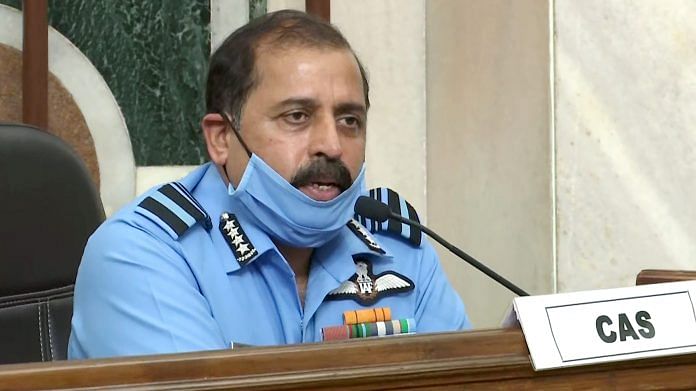New Delhi: The most important national security challenge facing India is understanding China’s intention in Ladakh and its “deepening and evolving” relationship with Pakistan, Indian Air Force (IAF) chief Air Chief Marshal R.K.S. Bhadauria said Tuesday.
Speaking at a seminar organised by the Delhi-based think tank Vivekananda International Foundation, the IAF chief also stated that the Chinese have deployed heavily in Eastern Ladakh, but the counter-actions taken by the Indian armed forces have ensured that the People’s Liberation Army (PLA) have “stopped in their tracks and they continue to remain there”.
Discussing the ongoing border standoff between India and China in Ladakh, he questioned if the Chinese aggression in the area is simply military signaling, or dominance efforts focussed in the region with adequate escalation control.
“What could be possible Chinese objectives for their action in the North (Ladakh)? It is important that we recognise what they have really achieved,” he said.
“Was it deployment and training of the western defence forces (Western Theatre Command) in real war-like scenarios where the Galwan incident was an overreach? Or was it fine-tuning and enhancing their military technology and recognise and fill their gaps to get their forces to synergise in new structures and new technology and whatever they have introduced?” he added. “Was it a planned escalation to start border talks from new positions… In any case, what has actually happened is all of the above.”
Everyone is aware, he said, that China’s main aspirations are clearly on the global front and regional domination is part of the route to global leadership that they aspire for. However, he added that any “serious India-China conflict isn’t good for China at the global front”.
“If Chinese aspirations are global, then it doesn’t suit their grand plan,” he said, lamenting the fact that the rule-based international order is being challenged, and that “a policy of contestation” is being given preference over traditional tenets of cooperation and collaboration by some countries.
Also read: China appoints new military commander for India border, but no change expected in stand-off
‘Pakistan a pawn in Chinese policy’
“Evolving uncertainties and instability” have provided China with an opportunity to demonstrate its growing power, and also indirectly brought to the fore the inadequate contribution of major powers to global security, Bhadauria said.
He added that Pakistan has increasingly become a pawn in Chinese policy, and noted that the US’ exit from Afghanistan has opened up increased options for China in central Asia, both direct and through Pakistan.
He said the Chinese aggression in Ladakh could also be a totally military-dominated misadventure that escalated amid a rapid decrease in trust in the post-Covid world.
“But the important issue is that we recognise what they have really achieved and whatever 4-5 points I mentioned have been auctioned in the real sense,” he said.
Asked what is the lesson learnt by India in terms of PLA force mobilisation and air asset deployment around the Line of Actual Control (LAC), he said they have deployed heavily in support of the army.
“They have deployed fully and have a large presence in the second tier and a large presence of radars and surface-to-air missiles and surface-to-surface missiles in the reckonable area,” he added. “So their deployment has been very strong.”
Also read: India has forced a stalemate in Ladakh. That’s a defeat for China






